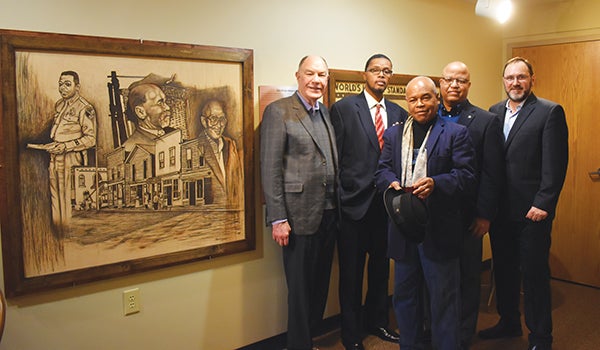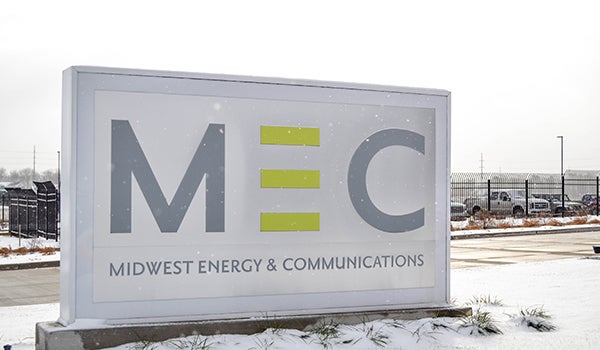Dowagiac Area History Museum dedicates new permanent exhibit honoring African American leaders
Published 8:52 am Thursday, February 20, 2020

- The Dowagiac Area History Museum dedicated a new permanent exhibit, “Time Brings About a Change,” featuring artwork by Dowagiac artist O’Larry Collins. The exhibition features two wood burning art pieces by Collins and depicts three African American residents in Dowagiac’s history: Thomas Jefferson Martin, Chief George Grady and Sam Fowlkes. Pictured from left: Mayor Don Lyons, Tyree Blackamore, the ninth grandson of Sam Fowlkes, Collins, Dennis Grady, the son of George Grady, and Steve Arseneau, the museum director. (Leader photo/HANNAH HOLLIDAY)
DOWAGIAC — A permanent exhibit featuring artwork by a local Dowagiac artist is now on display at the Dowagiac Area History Museum.
On Tuesday afternoon, a formal dedication was hosted to introduce a new permanent exhibit, “Time Brings About a Change,” with two wood burning art pieces, “Time Brings About a Change,” and “For Who?” both created by O’Larry Collins.
“Time Brings About a Change,” features three African Americans who had significant impacts on Dowagiac and Michigan’s history, Thomas Jefferson Martin, Chief George Grady and Sam Fowlkes, said Museum Director Steve Arseneau.
“It means a lot as an artist,” Collins said on Tuesday, standing in front of his work. “As a black artist and knowing George Grady and knowing Sam Fowlkes, it was a beautiful thing. They are real, nice, good people. It was a privilege for me to do [the piece]. When Mayor [Don] Lyons approached me about doing them, I thought so much of him for wanting to have that done for us here in Dowagiac.”
Representing George Grady, a Dowagiac native and decorated Korean War veteran, was his son, Dennis Grady, who said he had waited 43 years for someone to honor his father’s sacrifice and dedication to Dowagiac.
“My dad and I would have private conversations, and sometimes, he would get me up at 3 a.m.,” Dennis said. “One thing I remember about my dad was a lot of times, I cleaned his guns and shined his shoes. To this day, when I shine my shoes, I still remember what he had me do. He would talk to me about being a gentleman. He would say ‘Denny, if you are going to be anything, be a man.’”
George served as a deep-sea diver in the U.S. Navy during the Korean War. In 1955, he returned to Dowagiac and joined the police force. George rose through the ranks and, in 1965, was named the first African American police chief in the state of Michigan. He died at the age of 44 from a heart attack.
Dennis joined the Michigan State Police in 1979 and retired in 2003 after a 25-year career. He still remembers thinking of his dad while in the academy.
“I will die here before I let him down,” Dennis said.
Sam Fowlkes was one of Dowagiac’s local civil rights organizers and a leader in the African American community for decades, Arseneau said. Representing the Fowlkes family was Tyree Blackamore, the ninth grandson of Sam and Bessie Fowlkes.
“The two of them taught us to be proud, to be of standing members of the community, to speak for truth and injustice and to offer a hand to all— no matter the color of one’s skin or social status,” Blackamore said. “[Fowlkes] had an amazing ability to see the big picture and what that might mean for the community as well as us.”
Blackamore remembered when Fowlkes was reelected to Dowagiac City Council. He was often answering questions from residents of his ward and sharing his views on different situations.
Fowlkes was a local businessman and one of the first African Americans to serve on the city council. He served from 1965 to 1971 and again from 1986 to 1997. He also served on the Cass County Planning Commission from 1968 to 1997 and served as vice-chairman from 1988 to 1996.
In 1947, Fowlkes worked at Dowagiac Steel Furnace, while putting time towards his own upholstery shop, Fowlkes’ Upholstery. In 1962, Dowagiac Steel Furnace closed, and Fowlkes started driving school buses for Dowagiac Union Schools. He retired from the school district in 1979 but kept his upholstery business into the 2000s.
Lastly, Thomas Jefferson Martin’s remarks were made by Arseneau as his family line ended with his son, C. Fabe Martin, who had no children.
Martin was born in Tennessee to a white politician and his slave mistress. In 1820, Martin’s father granted him freedom. He became a barber and worked on steamboats alongside the Mississippi and Ohio Rivers. He was also active on the Underground Railroad in southern Indiana.
In 1855, he planted roots in Dowagiac and opened his own barbershop. He quickly became a leader of the state’s African American community as the elected chair of the first Michigan convention of African American residents hosted in Battle Creek in 1860. Martin would later call the second convention in 1884. He also led the state’s Prince Hall Free and Accepted Masons Lodge.
The exhibit was made possible by a donation from Don and Joan Lyons, of Lyons Industries in Dowagiac.
“When I first went into Mr. Collin’s shop and saw his work, “For Who?” I was dumbstruck,” Don Lyons said. “That was one of the most powerful images on the tragedy of racism that I thought I’d ever seen.”
Lyons said the image stuck with him for days, weeks and months afterward. He thought if it had such a positive impact on him, it needed to be shared.
Collins, who is also a downtown merchant, owns Art Enuh Suit.
“One of the things we are focusing on is to make the community more inclusive,” Lyons said. “If you go downtown, you don’t nearly have the African American presence that we would like to see.”
As the reception was about to end, Arseneau hoped this permanent exhibit would be the start of a larger one.
By 1910, Cass County had the highest concentration of African American residents in Michigan, outside of Detroit and Grand Rapids, according to census records, Arseneau said.
“Later, Dowagiac was a landing spot for many African Americans who fled the south to find work in factories and the rust belt during and after World War II,” he said. “Many of the families here today are a result of the migration during the post-war period.”
Arseneau encouraged families to look around their homes for artifacts and photographs to help tell the story of those families in Dowagiac and Cass County.
“Let’s make this the beginning of the museum’s relationship with the families here today and the local African American community,” Arseneau said. “This is your museum, too.”






